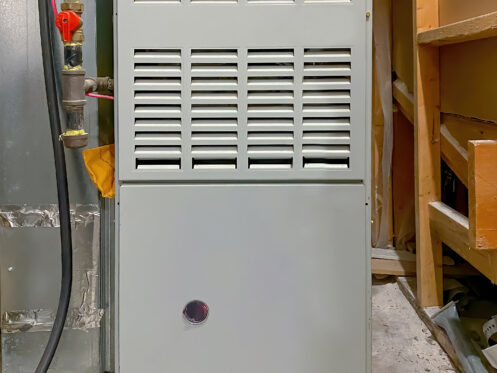Both a furnace and a heat pump heat up indoor air, but they differ in heating capacities, maintenance requirements, cost, and energy efficiency.
A furnace generates heat by burning gas or oil. In contrast, a heat pump does not create heat. Instead, it transfers heat from outside, even during cold winter days, and brings it indoors. While heat pumps do not generate as much heat as a furnace, a furnace consumes a lot more energy.
How Does a Furnace Work?
Many people have no idea how essential gas heating systems work. All they know is that during the winter when they turn up the thermostat, their home gets warmer. However, if you decide whether to replace your existing furnace with a new one or get a heat pump, it is a good idea to understand how these appliances work.
Understanding the Basic Forced Air Furnace Heating Cycle
A forced air furnace consists of a heating cycle with five primary functions. First, the furnace burner ignites propane or natural gas. Then, the flames from the burner elevate the temperature of the metal heat exchanger, while simultaneously allowing exhaust to escape the home through the flue. The cold air inside the heat exchanger is then brought up to the desired temperature. Next, the furnace blower propels the heated air through the ductwork, distributing the heat throughout the home and warming the air in each room. Simultaneously, colder, denser air is pulled back to the furnace via the return ducts, and the process repeats.
Components of a Gas Furnace
Several models of gas furnaces are available on the market, some with specialized functions. However, the majority share the common functions listed below.
Thermostat
The thermostat serves as a switch, sending signals to the furnace to turn on or off. It includes a control board that responds to homeowner inputs, determining the desired home temperature. When the home temperature falls below the set level, the thermostat activates the furnace to warm up the home. Once the desired temperature is reached, the thermostat deactivates the furnace.
Burners
Like a gas grill, the burners in a gas furnace consist of a series of tubes through which gas travels and is burned. A flame sensor, igniter, and gas valve control the flames. When the thermostat signals for heat, the gas valves open, and the gas ignites. A flame sensor ensures the gases burn properly; otherwise, the system shuts down.
Heat Exchanger
The heat exchanger comprises a series of metal tubes heated by the burners. The air inside the heat exchanger warms up before being distributed throughout the home. High-efficiency furnaces often feature more than one heat exchanger to enhance the heat transfer rate from the exchanger to the air.
Blower
The blower is responsible for pushing the heated air across the heat exchanger through the home’s ductwork. Some modern furnaces incorporate multi-speed blowers capable of adjusting the fan speed to enhance energy efficiency.
Flue
The flue is the vent that collects excess combustion gas generated in the heating process and expels it outside the home typically made from galvanized steel.
Pros and Cons of a Gas Furnace
Pro: Heat Your Home Faster
A gas furnace heats your home faster than a heat pump or electric furnace. This is advantageous during cold winter days when you want to raise your home’s temperature quickly.
Pro: Cost-Effective
Compared to an electric heater, a gas furnace is highly cost-efficient. Switching from an electric furnace to a gas furnace can result in significant annual savings, potentially amounting to hundreds of dollars.
Pro: Desirable
For those looking to sell their homes, many prefer homes with gas furnaces due to familiarity. This preference also extends to renters, as the installation and maintenance costs of a gas furnace do not directly impact them, resulting in savings on heating expenses.
Con: Relatively Short Lifecycle
Gas furnaces have a relatively short lifecycle, typically lasting between 15 and 20 years. In comparison, other forms of heating can endure up to a decade longer.
Con: Expensive Maintenance
Gas furnaces necessitate costly maintenance by HVAC technicians. The combustion process used in gas furnaces can lead to wear and tear, requiring preventive maintenance to prevent carbon monoxide leakage.
How Does a Heat Pump Work?
A heat pump uses technology similar to what you would see in an air conditioner or a refrigerator. It pulls heat from a heat source, be it air or geothermal energy, amplifies the heat, and then transfers it to where it is needed.
Heat pumps transfer heat as opposed to generating it. This means that heat pumps are a lot more energy efficient than gas furnaces and are usually a lot cheaper to run.
Components of a Heat Pump
Heat pumps are simple, yet deceptively complicated appliances. Here are some of the components that make them work.
Compressor
The compressor serves as the heart of a heat pump, moving the refrigerant through the evaporator and condenser coils to transfer heat.
Expansion Valve
This valve regulates refrigerant flow, controlling the amount of gas entering different components at any given time. It ensures that the various components receive sufficient refrigerant for optimal efficiency and performance.
Evaporator Coil
When used for cooling, the evaporator coil absorbs thermal energy and converts it into cool air inside your home or building.
Condenser Coil
In cooling mode, the condenser coil takes hot air from inside your home and releases it outdoors.
Refrigerant Lines
These lines connect the different components within the heat pump, allowing for maximum efficiency and comfort throughout your home or commercial space.
Reversing Valve
The reversing valve enables you to switch your heat pump from being an air conditioner to a heater. This flexibility means that, regardless of the season, your heat pump can be used to heat or cool your home.
Thermostat
The thermostat regulates the temperature in your home or building, instructing your heat pump to turn on or off or to heat and cool your space.
The Pros and Cons of Heat Pumps
Pro: Two Appliances in One
A heat pump serves the dual purpose of both heating and cooling your home, eliminating the need for separate furnace and air conditioner units.
Pro: Lower Heating Bills
Heat pumps boast up to three times the efficiency of a gas furnace, significantly reducing energy bills.
Con: Higher Upfront Installation Cost
Installing a heat pump can be up to twice as expensive as installing a traditional gas furnace. However, various government incentives are available to help offset some of these costs.
Con: Loss of Efficiency in Colder Weather
While heat pumps can effectively keep your home warm even in temperatures below zero, their efficiency decreases in colder weather. In areas where winter temperatures consistently reach double digits below zero, many homeowners choose to supplement a heat pump with a furnace for optimal efficiency.
Which One Is Right For You?
It is traditionally thought that heat pumps work best in areas that have milder winters such as coastal states and southern states. Furnaces have a greater ability to keep your home warm during cold, harsh winters and are better suited for northern locations. An HVAC professional can help you determine which appliance is best for your home.
Keeping Families in Vermillion, South Dakota Warm and Comfortable
At Kalins Indoor Comfort, we have been committed to keeping our customers warm and comfortable for more than a century. Our business has spanned three generations of family ownership. We offer stellar customer service, are focused on keeping our team trained, and are committed to what we do. As a result, we have won several awards and are proud to have an A+ Better Business Bureau rating.
Our services include HVAC and heating installation, maintenance, and repair. We offer radiant heating systems, heat pumps, indoor air quality testing, and air purifiers. Contact Kalins Indoor Comfort today and see for yourself what sets us apart from the rest.











